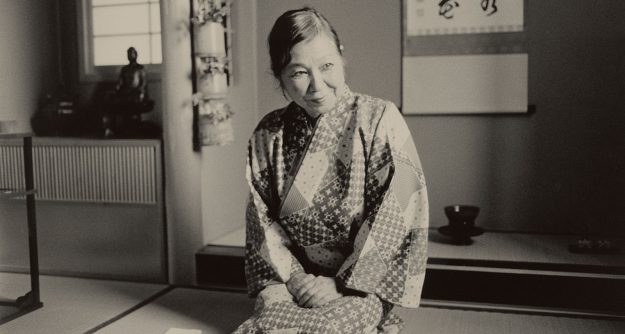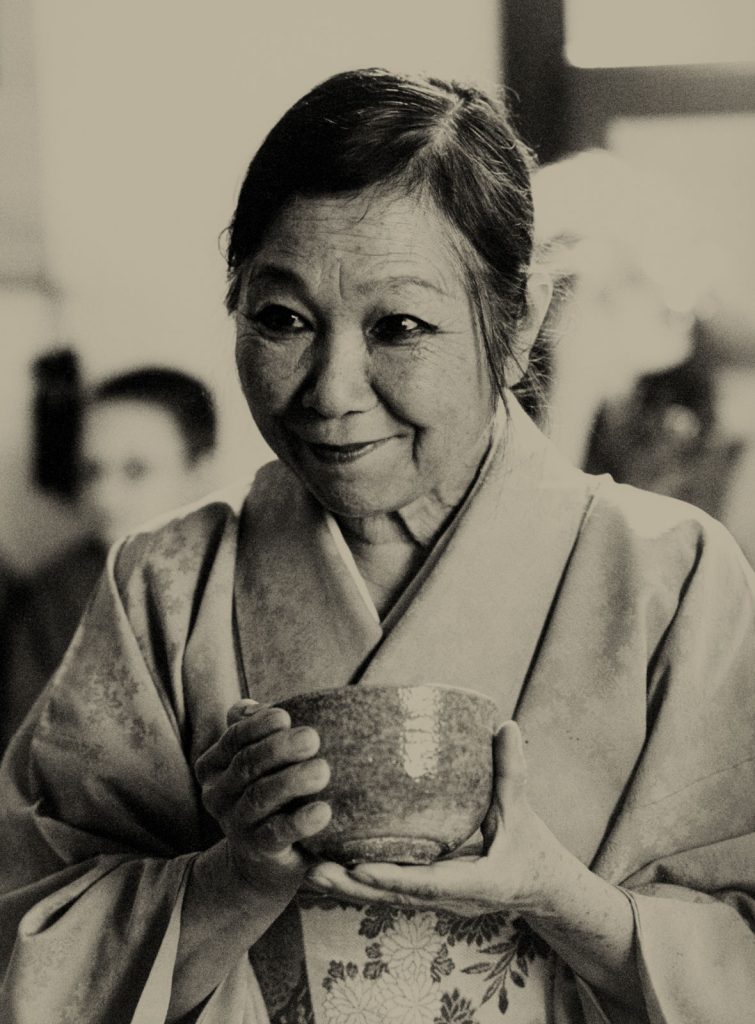Charlie Parker looked like Buddha. . . .
And his expression on his face
Was as calm, beautiful, and profound
As the image of the Buddha
Represented in the East, the lidded eyes
The expression that says “All is well”
This was what Charlie Parker
Said when he played, All is Well.
You had the feeling of early-in-the-morning
Like a hermit’s joy. . . .
Charlie burst his lungs to reach the speed
Of what the speedsters wanted
And what they wanted
Was his eternal slow-down. . . .
—Jack Kerouac, “Charlie Parker”
Jazz and Buddhism have their links, though no shared history. Both emerged, as the lovely and erudite impresario Yoshie Akiba points out, from the fires of solitude, introspection, suffering, and compassion. And both, of course, carry the weightless imperative of being in the moment, that continuous solo riff in the eternal expanding instant of the here and now.
In 1977, Yoshie opened Yoshi’s Nightspot, an Oakland jazz club so intimate that the late, great Betty Carter once stumbled over my daypack while weaving past the small round tables toward the eye-level stage. Seeing legendary jazz artists at the original Yoshi’s was like hosting them in your living room; there was a sense, even on the most crowded evenings, that everyone was approachable. We were all jazz lovers, pure and simple, united within the glow of spontaneous creation that inspired beat Zen masters like Jack Kerouac and Bob Kaufman.
Today, Yoshi’s occupies classier digs on the revitalized Oakland waterfront. Its reputation has also expanded. Yoshi’s has become more than a great jazz club/Japanese restaurant; it’s one of those institutions, like sourdough bread or the Exploratorium, that draw people to the San Francisco Bay Area and leave them with an indelible taste of the West Coast’s blithe, electric spirit.
Yoshie and her husband, a Japanese Soto Zen priest, live on a quarter-acre lot in North Oakland’s Rockridge district. Their compound is a world unto itself, an unofficial embassy of Japanese aesthetics and calm. A separate building houses their spacious zendo, open to the public for Sunday morning sittings. A female student leads me toward the main house, and I remove my shoes outside the four-and-a-half-mat room where Yoshie’s tea ceremony class is in progress.
Yoshie wears a bright purple kimono and long, glittering earrings. With her black hair tied in a bun, she comes across as impish and ebullient; one feels an instant kinship, an immediate sense of a new best friend. She instructs her students with uninhibited intimacy, scolding and praising, doggedly reaching for unattainable Zen perfection.
This black-eyed dakini was a World War II orphan, losing her father to a Manchurian prison camp and her mother to tuberculosis. Taken in by a private orphanage, she endured often unbearable loneliness—cultivating a trait she recognized, even during childhood, as a compassionate spirit. “I learned how to attract people, to be useful, to be helpful, to be kind. I learned how to connect with people. Because I went through so much suffering myself. So, to fulfill my loneliness, my answer was to reach out through kindness.”
As a young woman, she developed a strong interest in music and dance. “I was very lucky,” she laughs, “because I had a wealthy boyfriend, and he took me to the best nightclub in Japan. I really enjoyed it—and it became my dream to open my own jazz club.”
In 1973, Yoshie was a student at UC Berkeley, majoring in contemporary art, dance, and art history. Along with two friends—Kaz Kajimura and Hiro Hori, who are still her business partners—she began serving udon and sukiyaki in a small eatery on the north side of campus. The jazz club evolved from that seed, as did Yoshie’s attraction to Buddhism and the tea ceremony.
“I visited many temples in Japan, but I never practiced seriously,” she says. Her students have left; she has put away the tea bowls and whisk, and is serving red bean cakes and green tea in her cluttered kitchen. “My practice started when I was a student. Alan Watts gave a lecture on campus; that’s what drew me to Buddhism.
“But there’s another reason I started to study and practice Zen. It had to do with being a Japanese person in this country. America is so huge, so many things are happening, that if you don’t have a self, an identity, you’ll be blown away.
“So, not speaking the language very well and having few friends, I had to cultivate my inner self. Who am I? What does it mean to be Japanese? That was when I became deeply interested in Zen and, in 1977, the tea ceremony. Those things are at the core of the Japanese people.
“I’m basically lazy,” she insists. “I think everybody is basically lazy. But teaching tea, you cannot be lazy. You have to learn all about Japanese culture: flower arrangement, cooking, art and calligraphy, even Japanese architecture. It’s very involved; it takes a lifetime. So I have to keep studying.”
The twenty students studying tea with Yoshie range from eight to seventy years old: Japanese, Americans, Filipinos, Argentineans, Czechs, and Chinese.
“It’s very difficult to teach people through just meditation—so I’m teaching Zen Buddhism through tea. The tea ceremony is like a bridge between the material and spiritual worlds. It’s spirituality with forms, and rituals. When you study tea, you must study the Four Basic Principles: wa (harmony); kei (respect); sei (cleanliness); and jaku (silence/meditation).
“Learning tea, you learn how to use meditation in the real world. That’s why I get such good results. I see people improve. I scold them, I make them cry, but they come back! Their quality of life improves. And that is very exciting: to see people’s improvements.”
Yoshie’s own spiritual evolution is coaxed along by her husband, Reverend Gengo Akiba. They met when she was looking for a Japanese priest to bless the small zendo she and her partners had built in their attic. She was forty-three, and divorced. Gengo was at the San Francisco Zen Center, and abbot Suzuki Roshi’s wife introduced them. Though Gengo eventually returned to Tokyo, they continued to correspond.
For five years they had a chaste, student-teacher relationship. During one of Yoshie’s visits to Japan, though, the two returned late to Gengo’s temple. An eighty-three-year-old nun saw them together, and was scandalized. “Have you been to a ‘love hotel’?” she snapped. Yoshie and Gengo were shocked—“but it triggered something in us,” she recalls. “It made us confront our suppressed attraction. We thought: ‘Yes, that’s possible!’”
Some abbots might find it strange, being married to a jazz club owner; not Gengo. “I don’t distinguish between the material and spiritual worlds,” he says. “I can practice without conflict in daily life. In daily life, after all, everything is contained.
“Besides,” he adds dryly, “at the time we met, Yoshi’s wasn’t that popular!”

Yoshie is still an artist; jazz musicians like singer Dee Dee Bridgewater consider it the ultimate compliment when she emerges from the shadows and dances in a corner or the stage. The connection between music and spirituality emerges at Yoshi’s, encouraged in a way that’s both ethereal and literal: on the club’s thirtieth anniversary, Yoshie and her husband led a group of Soto Zen monks in a traditional Buddhist cleansing ritual.
“Jazz and Buddhism are both spiritual pursuits,” reflects Art Maxwell, a jazz shakuhachi player admired by Yoshie. “In the liner notes to the Miles Davis classic Kind of Blue, Bill Evans talks about a style of Japanese painting in which, once the brush touches the canvas, you can’t lift it off till it’s done. In the same way, jazz has immediacy, commitment, and spontaneity to it; it has to flow. Once you start your solo, you’re committed.”
His words are echoed by McCoy Tyner, a brilliant jazz pianist recruited by John Coltrane at the precocious age of seventeen. Tyner has been to Japan forty-six times—and though he was raised a Baptist, Yoshie considers him a quintessentially Buddhist musician.
“I try not to predict what’s going to happen,” Tyner says of his work. “I let the music happen—naturally. After all these years, it hasn’t let me down.
“Music is very spiritual—especially music that’s so personal, like the kind we play. You don’t have to talk about it; you don’t have to shout it from the rooftops. It’s about how you live as a person,” he says. “Yoshie always conveys her love for the music, and her willingness to support it. You can feel it in the club; it’s a house of worship.”
Yoshie herself agrees. Being a jazz musician, she muses, requires the one-pointed focus of a Zen master. Some of the greatest musicians are like bodhisattvas; they’ve certainly paid their dues. “Most jazz musicians have had very hard lives. They’ve gone through a lot of suffering,” she says. “If you don’t suffer, how can you understand other peoples’ suffering?
“Both jazz and Buddhism are really about people. Buddha said, ‘Go inside yourself, and find out yourself.’ But that’s not the end. That is the beginning of being able to help other souls; to show your compassion. But going into yourself is just part of the process. Once you know yourself, you go out.”
The original Yoshi’s was a phenomenon, a cozy oasis where the greatest names in jazz—Sarah Vaughan, Max Roach, Betty Carter, Stan Getz, and Oscar Peterson—played to small, adoring crowds. But traffic increased, and neighbors complained; after twenty-three years, the lotus outgrew its pond. In 2000, Yoshi’s moved, reopening on Oakland’s Jack London Square. The new club is bigger than the original, seating 410 and stretching a full city block. The restaurant serves world-class Japanese cuisine, and the jazz club is a triumph of acoustic design.
True, some of the funk and informality is gone. Yoshi’s no longer feels like a neighborhood secret. But its charms are different, and just as evocative. Outside the restaurant’s windows, between the marquee and the Bay, a silver ribbon of railroad track links the docks of Seattle with Los Angeles’ Union Station.
As the Coast Starlight rumbles south, throwing my pot stickers and unagi into brief shadow, I recall jazz-loving Allen Ginsberg’s Sunflower Sutra, his own beat version of the Flower Sermon, written as he sat right here in Oakland, with his Buddhist pal Jack Kerouac, fifty years ago:
—We’re not our skin of grime, we’re not our dread
bleak dusty imageless locomotive, we’re all
beautiful golden sunflowers inside, we’re
blessed by our own seed & golden hairy naked
accomplishment-bodies growing into mad
black formal sunflowers in the sunset, spied on
by our eyes under the shadow of the mad
locomotive riverbank sunset Frisco hilly tincan
evening sitdown vision.
Thank you for subscribing to Tricycle! As a nonprofit, we depend on readers like you to keep Buddhist teachings and practices widely available.
